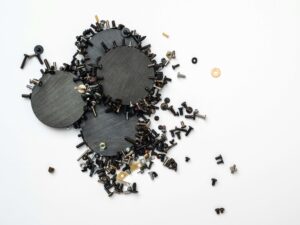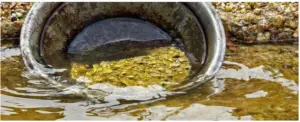If you want gold and do not have a metal detector, learning about the various ways how to detect gold without a metal detector can be really helpful. Although detecting gold without the aid of such detectors comes with a unique set of challenges, it is possible in one way or the other.
How to Detect Gold Without A Metal Detector
There are multiple ways you can detect gold without a metal detector. Some of the common ones are:
1. Visual Inspection
Doing a visual inspection is the initial technique for identifying gold deposits. The key reason is the distinct features that gold has.
The bright yellow color of gold sets it apart from many other minerals. The sheer visual appeal is what makes this technique intriguing and accessible. This bright yellow hue is a signature feature of gold.

Despite this being the case, you would have to recognize that not everything that glitter is gold. Relying on color alone may result in false positives. Other minerals like pyrite – commonly known as “fool’s gold” – have a resemblance color. This might lead to confusion for an untrained eye.
Key takeaway: Gold has a distinct, bright yellow color. While this method is not foolproof, visually inspecting rocks or soil for the characteristic color of gold can sometimes help.
2. Density Test
Another technique of detecting gold without a metal detector is carrying out a density test.
The density test entails a straightforward experiment. During the experiment, the weight of the sample is compared with its known volume. By doing a comparison, clues about the nature of the material being examined are gained.
If the substance exhibits a density higher than the expected for typical material, then it presents a possibility of gold. The method is particularly useful in screening materials for their potential gold content without the need for sophisticated equipment.
The key limitation of this approach is certain materials closely mimicking the density of gold. This means that there would be a possibility of misinterpretation. This is especially the case when dealing with minerals or compounds sharing similar characteristics in their mass and volume.
Key takeaway: Gold is a very dense metal, much denser than most other materials you might encounter. You can perform a simple density test by comparing the weight of an object of interest with a known volume. This can help you identify whether the material is denser than expected.
3. Magnetism
Magnetism, or lack thereof, does play a role in identifying gold without resorting to a metal detector. It is the inherent non-magnetic nature of gold that distinguishes it from multiple other metals.
The non-magnetic nature of gold becomes a powerful tool when strong magnets are employed while identifying minerals. Subjecting a sample to the influence of the magnets, materials exhibiting magnetic susceptibility would be ruled out effectively. This means that gold would be left behind.

For this method, it is important to be aware that the absence of a magnetic response in a sample does not conclusively confirm the presence of gold. The non-magnetic feature of gold only serves as a filter. Hence, additional tests and techniques are necessary for a more comprehensive analysis.
Also, caution needs to be exercised. Some minerals do share the non-magnetism feature of gold. Therefore, the exclusion of magnetic minerals does not guarantee the absence of non-magnetic materials that mimic gold.
Key takeaway: Gold is not magnetic, so you can use a strong magnet to eliminate magnetic minerals from your search. If you find a non-magnetic material, it doesn’t necessarily mean it’s gold, but it helps rule out some other common metals.
4. Scratch test
The scratch test is also another way how to detect gold without a metal detector. It is a rudimentary yet accessible technique in the preliminary assessment of gold. This is because of the mineral’s softness characteristic.
For the technique, a sharp object is used to create a mark on a surface. The aim of the method is to exploit the malleability of the gold, which sets it apart from harder materials. If the material being scrutinized does not resist the scratch and leaves a mark, it suggests the possibility of it being gold.
Do not forget that certain other minerals are relatively soft in nature. This means that they can exhibit comparable softness and potentially result in false positives or misinterpretations. Hence, you need to know that the test is a basic indicator rather than a definitive confirmation of gold’s presence.
Key takeaway: Gold is a relatively soft metal. You can try scratching the material with a sharp object. If the material leaves a mark, it’s probably not gold. However, this test is not conclusive, as some other minerals can also be soft.
5. Acid Test
The acid test, as a way of detecting gold, stands out as a distinctive and advanced technique. The method has been adopted due to the remarkable ability of gold to resist corrosion by most acids.

The main acid used is known as aqua regia. Agua regia is a mixture of hydrochloric acid and nitric acid and it has earned a reputation as the “royal water”. The reputation is associated with its ability to dissolve noble metals, like gold. The aggressive combination of acids creates an environment where gold is effectively broken down and identified.
For this method, you ought to be aware that the corrosive nature of aqua regia possesses inherent risks. Due to this, you need to make use of proper protective equipment like gloves and goggles. Also, the area where the method is conducted needs to be well-ventilated or under a fume hood. The reason for this is to reduce exposure to potentially harmful fumes.
Key takeaway: Gold is resistant to most acids, but it can be dissolved in a mixture of hydrochloric acid and nitric acid, known as aqua regia. This test is more advanced and requires caution, as the acids involved are corrosive and should be handled with care. This method is often used by professionals.
6. Traditional Gold Panning
Panning for gold stands as a time-honored and effective technique.
The process starts with filling a shallow, flat-bottomed pan with a mixture of sediment and water. The pan is then gently swirled and agitated, allowing the water to wash away the lighter materials while retaining the denser gold particles. As the swirling continues, the heavier gold settles to the bottom of the pan. This is what creates a concentration of the precious metal.

For the technique, the remarkable density of gold is what makes it a success. Unlike lighter materials like sand or gravel, gold’s higher mass makes it gravitate towards the bottom of the pan – this is during the swirling process.
The effectiveness of this technique is contingent on the proximity of a water source. Water presence helps with the initial mixing of the sediment and the ongoing rinsing away of lighter particles. Without a water source that is reliable, the process is impracticable.
Key takeaway: If you are near a water source, panning for gold is a traditional method. Gold is much denser than other materials in the sediment, so it tends to settle at the bottom of a pan. This method is often used in placer mining.
7. Professional Assay
This is the pinnacle of ways how to detect gold without a metal detector.
The process begins with the collection of representative samples from the site of interest. During this stage, the sample is carefully prepared for analysis. This makes sure that it accurately reflects the composition of the larger deposit. Once prepared, the sample then undergoes a series of comprehensive tests. Each test is designed to uncover different aspects of its mineral content.

In the course of the professional assay, multiple spectroscopic and chemical analyses are employed. They include X-ray fluorescence (XRF), inductively coupled plasma mass spectrometry (ICP-MS), and atomic absorption spectroscopy. All of them are aimed at providing detailed information about the elemental composition of the sample.
Unlike simpler and more rudimentary tests, a professional assay involves the meticulous examination of a sample in a laboratory setting, employing a diverse array of advanced techniques to unveil the true nature of the material.
Key takeaway: The most accurate way to determine if a material contains gold is through a professional assay. This involves sending a sample to a laboratory where it will be analyzed using various methods to identify and quantify the presence of gold.
Final Remarks
Without a metal detector, detecting gold can be a challenge as gold is not inherently magnetic or conductive like many other metals. However, this does not mean that gold cannot be detected without a metal detector. Visual inspection, density test, magnetism, scratch test, acid test, panning, and professional assay are the ways how to detect gold without a metal detector.








